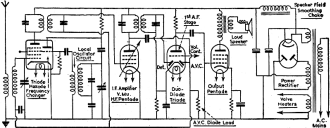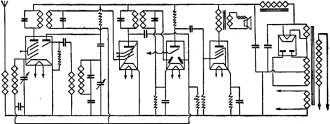Are Radio Symbols Wrong?
|
|
Do you remember back in the 1980s when adoption of the IEEE−type logic schematic symbols* got a big push? It proposed a logical approach (pun intended) to building any type of combinational logic or sequential logic devices based on strict rules of construction. Curved lines are nowhere in sight. Interestingly, the same type of schematic symbol "simplification" was proposed in the 1940s. The motivation for removing curved lines was to prevent draftsmen from needing to use a compass or special drawing template rather than using only a straight edge. Vacuum tube outlines, light bulbs, inductors, etc., required more time to pencil in. In 1944, this article entitled "Are Radio Symbols Wrong?" appeared in Radio-Craft magazine. It included a new method created by a D. S. B. Shannon (I.R.E., Great Britain) which replaced curved tube outlines with rectangles, curly inductor windings with diamonds, and curved capacitor plates with straight lines. He even modified tube plates to be solid rather than dashed. An example provided for work savings is that a triode-hexode tube requires 38 pen movements in the old version, and only 22 in the reformed drawing. A quick review of modern schematics shows that neither idea has been widely adopted. *See "Overview of IEEE Standard 91-1984" by Texas instruments. Are Radio Symbols Wrong? Standard drawing of a 5-tube super. Readers will recognize the English style at once. The drawing above, rendered in the Shannon style. Futuristic as it seems at first glance critical inspection shows it to be as easily read and straightforward as any schematic. Radio was cursed in its early days by hangovers from the electric industry, of which it is a direct descendant. Because the first electron tube was a slightly modified electric lamp, electron tubes continued to be made in the image of lamps for many years, in spite of the obvious disadvantages. Diagrams of radio circuits also suffer from the heavy hand of tradition, according to D. S. B. Shannon (I.R.E., Great Britain). Writing in Electronic Engineering, he suggests that many improvements from the draftsman's viewpoint could be made in diagrams. His proposals for improvement would result in a revolutionary change in at least the appearance of standard schematics. Present radio diagrams have many advantages. Although it is possible to determine by examining a diagram whether it was drawn in the United States, Great Britain or continental Europe, the modifications are so slight that radiomen from any country in the world, no matter what their language, can understand each other clearly through the medium of the schematic. Nor is the regular diagram difficult for the engineer or experimenter to draw. He can turn out a perfectly understandable sketch even of a complicated circuit suitable for working up into a blueprint or a schematic for publication, in an hour or two. The situation of the draftsman is not so happy. He may spend a day or more to produce a neat circuit layout from the rough hookup. In drawing the numerous details, each of which must be uniform with the others in the finished drawing, he is likely to note corners that might reasonably be cut. One of these time-wasting corners is the necessity of dropping the rule and picking up the compass whenever tubes, coils, and a few other symbols are to be represented. Another is the grid symbol. This is either a zig-zag line or a broken continuous line, which looks simpler, but actually takes more time to draw than the other. When there are several grids in a tube, such points become important. A system of drawing which would drastically reduce the number of movements required in representing standard symbols, without reducing the clarity of the meaning, would be worth while, in spite of the natural prejudice felt toward anything new in appearance, believes Mr. Shannon. He therefore proposes a method of drawing diagrams which will cut down the number of motions required in drawing standard tube symbols by approximately one-half, as well as making notable savings in other line work, due to the complete abandonment of the compass. The system is illustrated in the schematic shown here. Above we have a diagram drawn in the conventional (English) manner. Below it is the same diagram drawn in "reformed" style. Startling as it is on first glance, and resembling the art of the cubist, it is absolutely straightforward and easy to read. As an example of the difference in the amount of work required, the triode-hexode first tube requires 38 pen movements in the old version, and only 22 in the reformed drawing. The new symbols are not likely to be accepted immediately, in spite of the present tremendous shortage of draftsmen. Tradition is not easy to buck, and some of our American engineers could give Europe lessons in staid conservatism. There is, however, at present a movement to reconcile the symbols used by American communications engineers with those used in industrial and power circuits. If that desirable end should be brought about, the body entrusted with the work might well consider a complete rationalization of the whole system of drawing schematics. Since any standardization of symbols will bring changes in established signs, with a certain attendant confusion, it might be possible to introduce a thoroughgoing reform of present practices with little greater shock than is bound to ensue in any case.
Posted December 30, 2020 |
|


